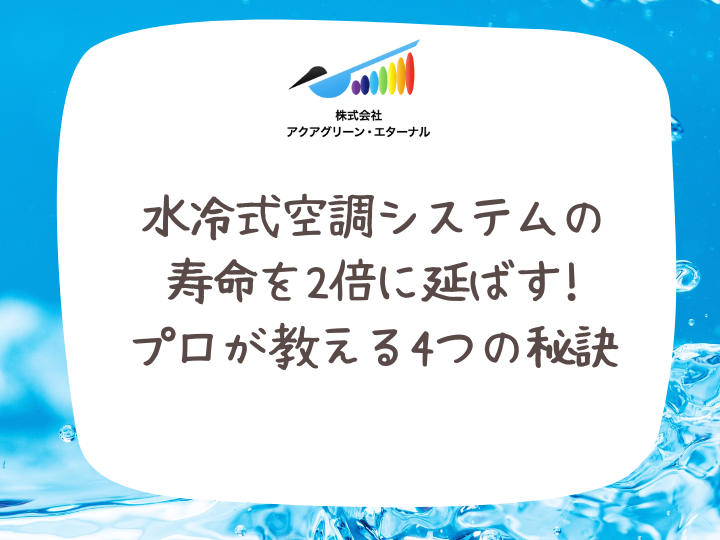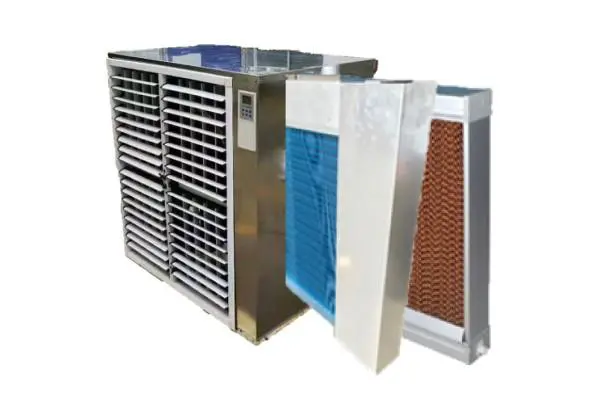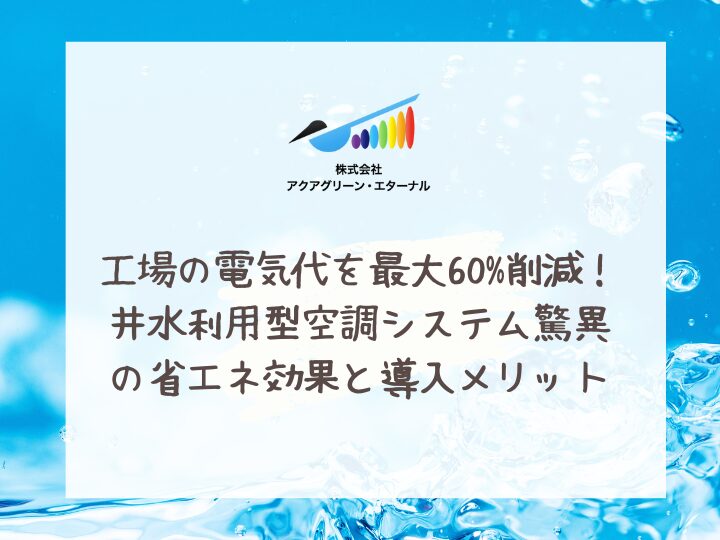4 tips from the pros to double the life of your water-cooled air conditioning system!
Regular water quality testing and purification treatment are essential to extend the life of water-cooled air conditioning systems. Inspection and cleaning of piping systems and proper management and cleaning of cooling towers are also important. In addition, regular evaluation and optimization of energy efficiency can maintain the performance and extend the life of the entire system. These comprehensive management strategies can be expected to reduce operating costs and improve system reliability.

The Importance of Regular Water Quality Testing and Purification Treatment
Water quality management is one of the most important issues in extending the life of water-cooled air conditioning systems. In particular, in factories that use groundwater or well water, water quality fluctuates significantly, so regular and precise water quality testing is essential. Deterioration of water quality causes corrosion and clogging of pipes and heat exchangers, which directly leads to reduced system efficiency and failure.
Water quality testing involves comprehensive analysis of pH, hardness, salinity, dissolved oxygen, electrical conductivity, and the presence of microorganisms. Of particular interest are scale-forming substances such as calcium and magnesium, corrosive substances such as iron and manganese, and the growth of microorganisms. It is important to quantitatively grasp these parameters and maintain them within acceptable ranges.
If a problem is detected, we will promptly implement appropriate purification treatment based on scientific evidence. For example, if the water is hard, it is effective to install a water softener using an ion exchange method or EDI (electrodeionization) method. If microbial growth is observed, we will consider installing a UV sterilizer or chlorine injection system. In addition, administering inhibitors to suppress corrosion and using scale inhibitors are also effective measures.
By implementing these measures comprehensively, not only can the system's lifespan be significantly extended, but energy efficiency can also be maintained. Furthermore, by accumulating and analyzing water quality data over the long term, seasonal and secular trends can be identified, enabling more effective water quality management strategies to be developed.
Regular inspection and cleaning of piping systems
The piping system of a water-cooled air conditioner is the core of heat exchange, and maintaining its performance is directly related to the overall efficiency. With long-term use, inorganic scale, microbial biofilm, corrosion products, etc. accumulate inside the piping, significantly reducing the heat exchange efficiency. These can eventually cause the entire system to malfunction, so regular inspection and cleaning based on a scientific approach is essential.
Inspections utilize non-destructive testing techniques to measure pipe thickness, detect leaks, and evaluate corrosion. For example, ultrasonic testing and eddy current testing can be used to accurately grasp the internal condition of pipes. It is also effective to use infrared thermography to visualize heat distribution and identify areas where heat exchange efficiency is declining.
If a problem is detected, prompt and appropriate action is required. For example, if localized corrosion is found, consider changing the material or applying anti-corrosion paint. Loose connections are addressed through proper torque management and regular retightening.
To clean the inside of pipes, chemical and physical methods are appropriately combined. For chemical cleaning, select the appropriate cleaning agent (acidic, alkaline, or neutral) depending on the type of scale, and perform circulating cleaning. For physical cleaning, use a high-pressure water jet or brush pig to remove stubborn deposits. Particular attention should be paid to neutralization treatment after cleaning and complete removal of residues. Failure to do so may result in new corrosion.
By establishing a comprehensive inspection and cleaning program and implementing it regularly, it is possible to maintain the efficiency of the system and extend its lifespan. Furthermore, by accumulating and analyzing historical data on inspection and cleaning, it is possible to set optimal inspection and cleaning intervals and predict areas where problems are likely to occur, leading to more efficient maintenance management.
Proper maintenance and cleaning of cooling towers
Cooling towers are the heart of water-cooled air conditioning systems, and maintaining their performance directly affects the overall efficiency and lifespan of the system. Because cooling towers are open systems that come into direct contact with outside air, contamination by dust, microorganisms, organic matter, and other substances from the atmosphere is unavoidable. These can cause various problems, including reduced cooling efficiency, accelerated corrosion, and the proliferation of harmful microorganisms.
The most important aspect of cooling tower management is microbial control. Legionella in particular requires strict management due to its pathogenicity. Effective microbial control requires a comprehensive strategy that combines multiple approaches. Specifically, the following methods are included:
1. Continuous injection of chlorine-based disinfectants: Maintain free residual chlorine concentration at approximately 0.2-0.5 ppm
2. Regular use of non-oxidizing germicides: Suppression of biofilm formation
3. Installation of UV sterilization equipment: Prevent the emergence of drug-resistant bacteria through physical sterilization
4. Ozone treatment: Sterilization and organic matter decomposition through powerful oxidizing power
Effective microbial control can be achieved by appropriately combining these methods and managing them in conjunction with regular water quality testing.
Physical cleaning of cooling towers is also important. Periodic cleaning is necessary because clogging of the filler material significantly reduces the heat exchange efficiency. A combination of high-pressure water cleaning and chemical cleaning can effectively remove dirt. Also, do not forget to clean the drift eliminator. If it becomes clogged, it will lead to increased water droplets splashing, resulting in water loss and increased hygiene risks.
Mechanical parts such as fans and motors also require regular inspection and maintenance. By introducing predictive maintenance techniques using vibration analysis and thermography, breakdowns can be prevented before they occur.
Additionally, it is worth considering introducing a remote monitoring system that utilizes the latest IoT technology. Real-time monitoring of water quality parameters, operating conditions, energy efficiency, and more will enable early detection of abnormalities and rapid response.
Implementing these comprehensive management strategies will maintain the performance and extend the life of your cooling tower, leading to increased system efficiency and reduced operating costs.
Regularly assess and optimize energy efficiency
Maintaining and improving energy efficiency is a crucial factor in extending the service life of water-cooled air conditioning systems. Inefficiency not only leads to increased energy costs, but also directly leads to shortened equipment lifespans due to excessive strain on the system. Therefore, regular evaluation and optimization of energy efficiency is a core part of a system longevity strategy.
Energy efficiency assessment requires a comprehensive and scientific approach, and the following steps are recommended:
1. Energy balance analysis of the entire system
Detailed measurements and analysis of input energy and output cold energy are performed to calculate the COP (coefficient of performance) of the entire system, which allows us to understand the overall picture of efficiency decline.
2. Performance evaluation of each component
- Refrigeration unit: Measures the temperature difference between the evaporator and condenser, the power consumption of the compressor, etc., and analyzes the deviation from the theoretical value.
– Cooling tower: Measure cooling water temperature, wet bulb temperature approach, fan power consumption, etc. to evaluate cooling efficiency
– Pumps: Measure flow rate, head and power consumption to calculate pump efficiency
– Heat exchanger: Calculate the heat transfer coefficient (U value) and evaluate performance degradation by comparing it with the design value.
3. Analysis of control system behavior
We evaluate the optimality of PID control parameters, the accuracy of various sensors, the responsiveness of actuators, etc. to confirm the stability and efficiency of control.
4. Long-term trend analysis of operational data
Analyze seasonal and aging patterns to identify trends in efficiency decline.
Based on the results of these evaluations, we identify the causes of efficiency decline and take appropriate measures.
for example:
– Deterioration of heat exchanger efficiency: Remove dirt by chemical or physical cleaning, or upgrade to a more efficient model
– Deterioration of pump performance: Replacement of impeller, upgrading to a high-efficiency motor, introduction of variable speed control
– Declining efficiency of refrigerators: Repairing refrigerant leaks, maintaining and updating compressors, optimizing control logic
– Control system failure: Calibration and replacement of sensors, optimization of control logic, latest AI control system
One possibility is to introduce a stem.
In addition, it is also important to review the operation of the entire system. For example, the operation method under partial load
Optimization of operations, active use of free cooling, and load leveling through the introduction of thermal storage systems.
These measures are not just about improving energy efficiency.
This reduces the load on the equipment and contributes to extending the life of the entire system.
Improved performance through the introduction of the latest technology
Introducing the latest technology is extremely effective in extending the lifespan and improving the performance of water-cooled air conditioning systems
In recent years, with the development of IoT (Internet of Things) and AI (artificial intelligence) technology,
Innovative methods for operational management are emerging. By using these technologies appropriately,
This makes it possible to simultaneously improve system efficiency, improve preventive maintenance, and extend the service life of your systems.
- Real-time monitoring with IoT sensors:
By placing high-precision IoT sensors throughout the system, temperature, pressure, flow rate, power consumption,
This allows you to collect data such as the following in real time:
This makes it possible to detect abnormalities early and immediately detect signs of declining efficiency. - Predictive maintenance using big data analysis and AI:
By analyzing the collected data with AI, it is possible to predict signs of failure with a high degree of accuracy. For example,
Predicting equipment deterioration from minute changes in vibration patterns, and predicting energy efficiency from changes over time
This allows you to identify the optimal timing for maintenance and identify the problem.
This allows you to take appropriate measures before the problem worsens and prevent sudden failures. - Simulation with Digital Twin:
Build a digital model (digital twin) of the entire system and simulate it under various operating conditions.
By performing simulations, it is possible to derive optimal operating parameters.
This allows the system to maintain optimal operation at all times regardless of seasonal or load fluctuations, maximizing system efficiency.
It will be possible to do this. - Advances in automatic control systems:
The AI-based automated control system automatically monitors outdoor conditions, building usage, and energy costs.
This allows for optimal operation control that takes into account fluctuations in the weather. For example,
The cooling water temperature was adjusted in advance and demand response control was performed according to the power supply and demand situation.
By doing so, we can achieve both energy efficiency and economy. - Utilizing virtual sensors:
For locations where it is difficult to install physical sensors or parameters that are difficult to measure directly,
By utilizing "virtual sensors" that combine sensor data and mathematical models,
This gives you a much more detailed picture of the condition of your system. For example, this allows you to see if there is fouling inside the heat exchanger.
This makes it possible to estimate the leakage level or indirectly monitor the refrigerant charge level.
By appropriately combining these latest technologies and introducing them as an integrated system,
The operation and management of air conditioning systems will evolve to a new level. However, when introducing the technology,
The balance between cost and effectiveness, compatibility with existing systems, and security measures must be taken into consideration.
In order to effectively utilize these advanced technologies, operations managers must
It is also essential to improve the technical capabilities of the companies and establish a support system with experts.
The long life and efficient operation of water-cooled air conditioning systems is not just about maintaining and managing the equipment, but also about
A comprehensive approach is required that includes leveraging technology and optimizing operational methods.
Maintenance based on the professional knowledge and experience of our local staff, and the appropriate introduction of the latest technology.
This improves system reliability, reduces operational costs, and reduces the environmental impact at the same time.
It is now possible to do so.


